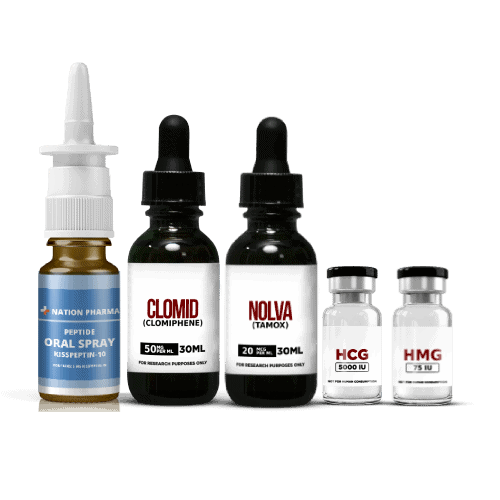Protocol for Researching the Get the Wifey Pregger Stack:
Kisspeptin-10 – For research purposes only, 7 sprays daily.
Clomid – For research purposes only, 1 filled oral syringe daily.
Nolva – For research purposes only, 1 filled oral syringe daily.
HCG – Prior to research, HCG should first be reconstituted with bacteriostatic water by injecting bacteriostatic water in the vial of HCG. A 500IU dose (1/10th of the bottle) should be used every 3 – 4 days. HCG can be researched for 2 – 8 weeks.
HMG – Prior to research, HMG should first be reconstituted with bacteriostatic water by injecting bacteriostatic water in the vial of HMG. A 75IU dose should be used 3 days per week. HMG can be researched for 2 weeks.
Kisspeptin-10:
Kisspeptins (including kisspeptin-54 (KP-54), formerly known as metastin) are proteins encoded by the KISS1 gene in humans. Kisspeptins are ligands of the G-protein coupled receptor, GPR54. Kiss1 was originally identified as a human metastasis suppressor gene that has the ability to suppress melanoma and breast cancer metastasis. Kisspeptin-GPR54 signaling has an important role in initiating secretion of gonadotropin-releasing hormone (GnRH) at puberty, the extent of which is an area of ongoing research. Gonadotropin-releasing hormone is released from the hypothalamus to act on the anterior pituitary triggering the release of luteinizing hormone (LH), and follicle stimulating hormone (FSH). These gonadotropic hormones lead to sexual maturation and gametogenesis. Disrupting GPR54 signaling can cause hypogonadotrophic hypogonadism in rodents and humans. The Kiss1 gene is located on chromosome 1. It is transcribed in the brain, adrenal gland, and pancreas.
Clomid
Clomifene, also known as clomiphene, is a medication used to treat infertility in women who do not ovulate, including those with polycystic ovary syndrome. Use results in a greater chance of twins. It is taken by mouth once a day, with a course of treatment that usually lasts for five days.
Clomifene is sometimes used in the treatment of male hypogonadism as an alternative to testosterone replacement therapy. The medication has been used at a dosage of 20 to 50 mg three times per week to once daily for this indication. It has been found to increase testosterone levels by 2- to 2.5-times in hypogonadal men at such dosages. Despite the use of questionnaires in testosterone replacement comparator trials being called into question, clomifene’s lower cost, therapeutic benefits, and greater value towards hypogonadism improvement have been noted.
Nolva
Tamoxifen is used for ovulation induction to treat infertility in women with anovulatory disorders. It is given at days three to seven of a woman’s cycle.
Tamoxifen improves fertility in males with infertility by disinhibiting the hypothalamic–pituitary–gonadal axis (HPG axis) via ER antagonism and thereby increasing the secretion of luteinizing hormone (LH) and follicle-stimulating hormone (FSH) and increasing testicular testosterone production.
Tamoxifen is used for ovulation induction to treat infertility in women with anovulatory disorders. It is given at days three to seven of a woman’s cycle.
Tamoxifen improves fertility in males with infertility by disinhibiting the hypothalamic–pituitary–gonadal axis (HPG axis) via ER antagonism and thereby increasing the secretion of luteinizing hormone (LH) and follicle-stimulating hormone (FSH) and increasing testicular testosterone production.
HCG
Human chorionic gonadotropin (hCG) is a hormone for the maternal recognition of pregnancy produced by trophoblast cells that are surrounding a growing embryo (syncytiotrophoblast initially), which eventually forms the placenta after implantation. The presence of hCG is detected in some pregnancy tests (HCG pregnancy strip tests). Some cancerous tumors produce this hormone; therefore, elevated levels measured when the patient is not pregnant may lead to a cancer diagnosis and, if high enough, paraneoplastic syndromes, however, it is not known whether this production is a contributing cause, or an effect of carcinogenesis. The pituitary analog of hCG, known as luteinizing hormone (LH), is produced in the pituitary gland of males and females of all ages.
HMG
Menotropin (also called human menopausal gonadotropin or hMG) is a hormonally active medication for the treatment of fertility disturbances. Frequently the plural is used as the medication is a mixture of gonadotropins. Menotropins are extracted from the urine of postmenopausal women.

